Historical Series: Magnetic Sense of Birds
That Nest of Wires We Call the Imagination: A History of some Key Scientists Behind the Bird Compass Sense
By Lisa Pollack
May 2012See other related articles by L. Pollack
Download the following article, PollackMagSensors.pdf
“Cheer Up, Men, Birds Also May Be Drafted,” read a lighthearted headline in the Brooklyn Eagle in January 1941. The world was fully focused on World War II, and a group of diminutive but tenacious soldiers was key to British, Australian, and U.S. military endeavors: homing pigeons. Their navigational abilities had been known and tapped since the ancient Romans, and though radio communication had improved since World War I, these expert flyers were still a valuable asset when wireless communication failed. Many were even carried under soldiers' coats onto the beaches of Normandy.
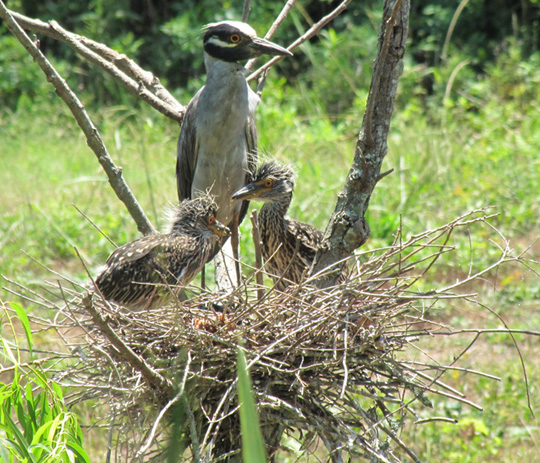
Photo of Yellow-crowned Night-Herons taken by Heidi Huber in Louisiana in June 2011.
Estimates are that over 16,000 pigeons were parachuted onto the continent in the war, and less than one percent of the messages they carried even needed to be encoded, since these feathery couriers were so successful in reaching their destinations. Many birds were presented with the Dickin Medal for gallantry, an award given by the British government.
Yet what makes homing pigeons and other birds such astute navigators, on a small scale and a large scale? The war pigeons were trained to fly fifty or sixty miles, but the bar-tailed godwit has been recorded, with surgically implanted satellite transmitters, to fly non-stop up to 7,100 miles. Many mechanisms are at work in bird navigational ability, but the most elusive one to humans may be how they sense magnetic fields. Although conjecture in the late nineteenth century held that birds could use the earth's magnetic field, it was only in the 1960s that scientists first demonstrated this experimentally.
But the bigger questioned remained: How do birds sense the magnetic field?
The answer may very well be that a biochemical reaction, called the radical pair reaction, acts as the magnetic sensor. This reaction involves a duo of radicals, molecules with unpaired electrons. Although anyone can literally see how the earth's magnetic field rotates the needle of a compass, in the radical pair process, a magnetic field actually affects the final products of a chemical reaction, a subtle effect to witness. But the underlying mechanism, in which a magnetic field can influence a reaction via quantum mechanical processes involving spin, has been witnessed and documented since the 1970s. Thus radical pair history is intertwined with the history of the avian magnetic compass, so we look to its early history to begin.
“What was a surprise for everybody, including myself, was that this quantum process would actually lead to a very significant change in the chemical reaction,” says Klaus Schulten, speaking about how the radical pair reaction was first received by the scientific community in the late 1970s. Schulten is still working in this field, currently trying to theorize the possible radicals that might be involved in the animal magnetic sensor. He and other scientists in many disciplines are working to prove that this model is indeed the basis of a compass in birds. Although the leap from the radical pair mechanism to biological magnetic sensor came almost instantly to Schulten, he wasn't the only one trying to show how a magnetic field could affect a chemical reaction.
Simultaneous discoveries are certainly not unheard of in science; Newton and Leibniz both discovered calculus in the late 1600s, for example. Two of the key players behind radical pair theory and magnetic field effects in solution, working a mere 245 miles apart, both wove together knowledge from two disparate sub-fields to arrive at their conclusions, but the similarities between these two German scientists end there.
Rumors Abound that Klaus Schulten is Crazy
The Max Planck Society in Germany, a collection of about eighty research institutes encompassing both sciences and humanities, has roots as far back as 1911.
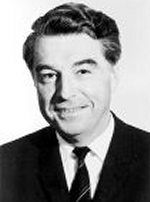
Albert Weller, a director of the Max Planck Institute for Biophysical Chemistry from 1971-1990. Image taken from here.
Albert Weller, the scientist who hired Schulten, was an experimentalist who became a director of a Max Planck Institute in Göttingen in 1965. When two Max Planck institutes in Göttingen merged to become the Institute for Biophysical Chemistry in 1971, Weller stayed on as a director. Although Weller was a leader in the field of electron transfer, something about one of his pet reactions involving radical ions puzzled him. One of the products observed in the reaction arose faster than Weller had ever seen it under normal circumstances. Since this mysterious product was an excited molecule with a pair of electrons whose spins were parallel, it was called a “fast triplet,” the triplet referring to the spin state of the electron pair. Using the tools of a theorist, Schulten set to work on the fast triplet enigma.
“I figured out where it comes from and I also figured out that with magnetic fields you could verify it by doing the reaction with and without magnetic fields and then I made this suggestion,” recalls Schulten. In other words, he talked freely with the other scientists at the institute about the proposed effect of a magnetic field on Weller's pet reaction. Soon, however, rumors were flying that both Schulten and his idea were crazy. These rumors made it to Schulten's ears, and quickly they became so loud and clear that he knew he had to respond to them. Finally he asked who was spreading these criticisms, and he got his answer: Hubert Staerk, the main lab manager.
Schulten liked and respected Staerk. In fact, he thought the lab manager was a very reasonable person, and so Schulten had no worries approaching him directly. Once in Staerk's office, however, the lab manager repeatedly told Schulten that his suggestion had to be wrong, that there was no way to see the effect. Schulten countered that his calculations showed the effect to be there, and asked why they couldn't just do the experiment. But Staerk never gave a reason why Schulten had to be wrong, he just continually insisted it would never work.
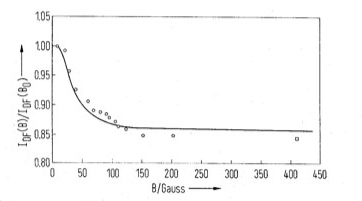
Magnetic field dependence as measured in the laboratory by Hubert Staerk and colleagues.
When Schulten kept pressing for a reason, Staerk finally admitted that, prompted by Weller, he had already done the experiment and just didn't see the effect. Schulten was crushed at this news. After thanking Staerk for doing the experiment, Schulten turned to leave. “In a minute,” wrote T.S. Eliot, “there is time for decisions and revisions which a minute will reverse.” In that minute, almost out the door, Schulten turned back and asked to see the data. Staerk had it handy, right on top of his drawer, as though he had shown it to other people. Schulten jumped with happiness when he looked: he clearly saw the effect he had predicted. “There was a little reduction in the signal,” recalls Schulten, “exactly what I expected, and so I was very happy that I saw it. A disaster turned into a happy moment, because I knew what to look for. He didn't.” Schulten says he never held it against Staerk.
But how did Schulten, a theorist, arrive at his conclusion that a magnetic field could influence a chemical reaction? “I took the well-known description and knowledge of the behaviors of electron-nuclear spin and I combined it with a diffusion process and a reaction process that happened when these kind of molecules are close together and interfere and interact with each other. Then I could calculate that there should actually be a significant percentage of change in the concentration of molecules.” Schulten essentially combined knowledge from two dissimilar fields, nuclear magnetic resonance, and diffusion controlled reaction theory, and crafted his prediction. And Weller had the experimental means to verify this explanation of fast triplets, so Schulten could know immediately if his calculations were correct.
Dejection at the Bar
But Weller's group was not the only one puzzling out fast triplets. Across the nation, in Bavaria, Maria-Elisabeth Michel-Beyerle, a post-doc at the Technical University of Munich, was studying molecular crystals and all kinds of related exciton phenomena. One can imagine Schulten's surprise when, shortly after he saw the data that proved his prediction on fast triplets, he inadvertently learned that Michel-Beyerle had just discovered something similar.
In science, formal exchanges of information may happen at conference talks, but there is a whole underworld of informal exchanges that happen as well, off record. It was during one of these informal instances that Schulten learned disheartening information from Michel-Beyerle, as he recounts: “She was there at the bar and we were drinking a beer. We were sounding each other out, and it turned out suddenly that she had done this experiment too. So she was telling me and then I got nervous.” Schulten says he would never have disclosed his new results to anyone, since he wanted to be the first to claim the discovery, and he was nervous that this would be in jeopardy if he talked. But he was torn by another factor: “If I don't now tell what I know, she may say I went home to do the experiment.”
So Schulten confessed what he had just discovered. Schulten believes what happened over that beer was that Michel-Beyerle was overstating her case. Michel-Beyerle has no recollection of this informal meeting with Schulten. But her road to the discovery couldn't have been more different than Schulten's. It is not that there was one key unlocking the mystery of the fast triplets; there were two different keys to the same door.
Michel-Beyerle's Path to Discovery
“I think the originality is Merrifield,” says Michel-Beyerle, explaining how she came to comprehend the mystery of the fast triplets. In 1972, a group of physicists at DuPont in Delaware, led by R. E. Merrifield, wrote a pivotal paper in Physical Review Letters, where they described the magnetic field effect on delayed fluorescence in anthracene crystals. Since Michel-Beyerle was then working in the field of molecular crystals, she knew this paper, its description of triplets, and specifically the magnetic field dependence. “This magnetic field effect was there, already existing fully in the field of molecular crystals. I mean, not many people know this, and people have forgotten this experiment now,” she recalls.
|
"WHAT IS SAID OVER A GLASS OF BEER DOESN'T COUNT." Ed Schlag |
Late one night, perusing The Exciplex, which is a compilation of papers from the International Exciplex Conference held in 1974 in Canada, she was concentrating on a long article by Naomi Orbach and Michael Ottolengi about fast triplets. “He sums up everything and in the end says ‘I do not understand.’” Michel-Beyerle realized that what was there in molecular crystals should hold for solution. “And all of a sudden, everything fell in place,” she recalls. “I understood the entire story in one night.”
But understanding the bigger picture and being able to do the experiment immediately to prove her conjecture were two different things. Michel-Beyerle had obstacles to overcome: she had never worked in solution, and she did not have access to the right equipment. The latter was the greater problem, however: “It took one or two years until I could do the experiment, because I had no instrumentation.” She finally was able to borrow an oscilloscope from her colleague at the university in Munich, Ed Schlag. Working through the night, using a nitrogen laser and that oscilloscope, they discovered the effect, that a magnetic field could influence a chemical reaction.
Schulten and Michel-Beyerle both published their findings in 1976, but Schulten and his co-authors published first. In the end of Michel-Beyerle's paper, there is a “note added in proof” which acknowledges similar studies that had just been done by Schulten et al. Yet Schulten says he still complained bitterly, about that night over a beer where he felt obliged to share what he knew about fast triplets. But he says he will never forget Ed Schlag's response: “What is said over a glass of beer doesn't count.”
An End to the Charlatans
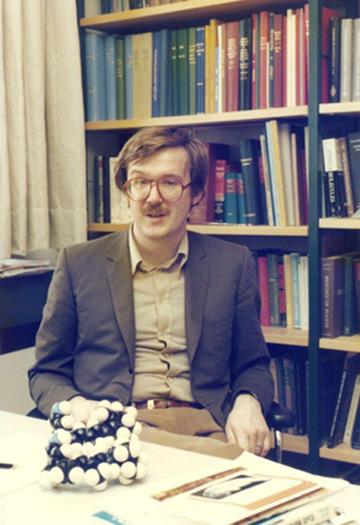
Klaus Schulten in 1978 in his office at the Max Planck Institute
Magnetic field effects on chemical reactions can occur in solids, liquids, or gases, and in interfaces and biological systems. However, Ulrich Steiner and Thomas Ulrich, in their 1989 comprehensive review article, argue that most magnetic field effects documented have occurred in solution, due to favorable radical pair mobility. “The so-called radical pair mechanism,” they write, “turned out to be a most valuable key for systematically tracing out magnetic field effects on chemical yields and kinetics.” In this mechanism two radicals are formed in tandem, and each of their unpaired electrons has a spin state associated with it. The two options for the radicals are a pair with two antiparallel spins (↑↓, a singlet) or, conversely, a pair with two parallel spins (↑↑, a triplet). An external magnetic field can cause interconversion between the singlet and triplet states. The radical pair is highly reactive, and a triplet forms a different chemical product than a singlet does. Due to quantum mechanical processes, the singlet-to-triplet interconversion, (hence the reaction yield) varies with the direction of the external magnetic field. Consequently, this is the way a magnetic field affects a chemical reaction.
Since spin is a quantum phenomenon, quantum mechanics is at the heart of understanding radical pair reactions. In fact, the atmosphere at the time that Schulten looked to the quantum mechanics of nuclear and electron spins to explain fast triplets was apparently rife with many irreproducible claims of magnetic field effects; so much so that in 1976 the colorful chemist Peter W. Atkins wrote, “The study of the magnetic field effects on chemical reactions has long been a romping ground for charlatans.” Schulten explains why for many years scientists didn't believe magnetic fields could influence a chemical reaction: “People didn't expect that to happen because they didn't think in terms of quantum physics, but rather in terms of just applying the energy of a magnetic field to molecules, to somehow make them move somewhere.”
The groups above proved by 1976 that a magnetic field could affect a certain kind of chemical reaction, one taking place in solution and instigated by light (hence called a photochemical reaction). In contrast, a thermal reaction is one that happens spontaneously at the temperature set in the laboratory. A photochemical reaction was not the only kind scientists were studying to elucidate magnetic field effects. As early as 1973, Russian researchers in Novosibirsk showed a thermal reaction in solution could exhibit a magnetic field effect caused by the radical pair mechanism. Spearheaded by Yuri Nikolaevich Molin and Kev Minullinovich Salikhov, Russian workers published many studies of magnetic field effects in thermal reactions in the 1970s.
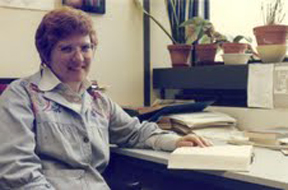
Zan Luthey-Schulten in 1978 in her office at the Max Planck Institute
At the same time, the group at the Max Planck Institute continued to elaborate on their initial work, which was presented more as a theoretical sketch than as an overt quantitative analysis. Working with his wife, Zaida “Zan” Luthey-Schulten, the couple expanded on the first publication by giving a more sophisticated treatment of the diffusion aspect. At this time, Schulten was mentoring a student of Weller's, Hans-Joachim Werner, who was earning his Ph.D. in chemistry. The three theorists, Werner and the married couple, teamed up for an extensive quantitative description to back up their initial, principled proposal, and discovered that simple patterns emerged to explain the radical pair mechanism. But things were getting complicated for the married couple. It became clear to them that working as a team and publishing together was hurting Luthey-Schulten's chances of establishing her own scientific voice, for it appeared to some that she was riding on her husband's coat tails. Michel-Beyerle also confirms that this decade was a difficult one for women in science and was even more sexist than today's sporadically hostile environment. The mammoth project that the couple worked on with Werner would be one of their last for a long time, as they realized they needed to separate professionally. They would not be able to work together until many years later, and are not the only power couple in this story forced to separate for the benefit of their careers.
An Original Idea Pummeled
Although many researchers in the 1970s were also puzzling out how a magnetic field could affect a chemical reaction, it was Schulten who immediately realized this mechanism could act as a compass sensor in biological species. Recognizing the potential importance of the discovery, he set about publishing this hypothesis as quickly as possible, keenly aware of his competitors in this growing field. He wrote a brief, principled paper proposing a biochemical compass as the avian magnetic sensor, and sent it to Science, a top American journal.
“A less bold scientist would have designed this piece of work for the wastepaper basket.” Schulten, over thirty years later, can still quote from the Science referee report he received from his magnetic sensor submission. Although thrashed by the top scientific gatekeepers, Schulten was not about to abandon his theory. He now wanted to publish his paper as quickly as possible: “I sent it to the most meager journal in the world. That's actually why the first paper, which is today a very highly cited paper, went to this very meager journal.” So late in 1978, in the journal Zeitschrift für Physikalische Chemie, with co-authors Charles E. Swenberg and Albert Weller, Schulten finally staked his claim.
It would seem that the jump from radical pairs to compass sensor would require thinking outside one's specialized field. Asked how widespread was the idea in the mid-1970s that birds used the geomagnetic field to navigate, Schulten answers, “basically I would say any erudite physical chemist knew about this open mystery of navigating migratory birds.” But only a decade earlier, some of the very biologists who were trying to solve this “open mystery,” and who have played a key role in the radical pair history, were struggling with their own battles of dismissal by the scientific gatekeepers.
Unexpected Realization
Wolfgang Wiltschko did not set out to prove birds use a magnetic compass. “It was a failing of another experiment,” that led him to this path, he recounts. In 1958 Wiltschko started graduate work at J. W. Goethe-University in Frankfurt am Main, joining the group of Friedrich Wilhelm “Fritz” Merkel, a biologist well known for his studies on the orientation of birds. Although suggestions were made in the late nineteenth century that birds could use magnetic information for navigation, they were met with disbelief. Henry L. Yeagley's work in the late 1940s, which led him to postulate that pigeons use the earth's magnetic field, was also not generally accepted. In other words, when Wiltschko started his studies at Frankfurt, very few scientists believed birds used the magnetic field, and even fewer were studying this phenomenon. He talks about the climate he faced: “You see, when we started at this time in the early sixties, everybody believed that birds can only orient by celestial cues, like sun and stars.”
In fact, however, another graduate student of Merkel's, Hans Fromme, had just discovered that certain birds could orient in closed rooms without stars. Wiltschko said this finding was highly debated, and his advisor Merkel wanted Wiltschko to replicate the controversial finding. Merkel specifically wanted Wiltschko to prove these birds could orient without the stars, and then to find out what they were using instead. Wiltschko, luckily or unluckily, had some clues to work with, which he describes: “[Hans Fromme] finished his thesis by saying that there are two possibilities. One is magnetism, and the other is that the birds hear radio signals, receive radio signals, from the stars.”
Wiltschko freely admits that he didn't believe the magnetism hypothesis of Fromme (who had done some work with strong magnetic fields and didn't see any reaction from the birds), and he set out to prove it was the radio frequencies that allowed birds to orient. In the course of his investigation, he put European robins in a steel chamber, which also partially shielded the earth's magnetic field, so that the birds were in weak magnetic fields. The steel chamber had been designed by a colleague working on extraterrestrial biology, who wanted to simulate space conditions; but since its electronics were not working, it was sitting unused at the institute. Both Wiltschko and Fromme tested their birds in it.
Before his outdoor trials were to begin, Wiltschko kept the European robins in the steel chamber for many days specifically to change their internal clock. “And then just to look if a bird is active,” recalls Wiltschko, “I tested them in an orientation cage, in a shielded room, and they were perfectly oriented.” He realized that the birds grew accustomed to the weak magnetic field and then used it to orient. This was a crucial discovery for him: “I still know that was the 12th of October, 1963.”
After this October epiphany, Wiltschko did further experiments in which he changed the magnetic field in the chamber with Helmholtz coils and studied the robins' subsequent orientation. Since Fromme had used far too strong magnetic fields with his birds, Wiltschko used the correct strength, since the birds have a limited range of magnetic field intensities they can detect. With Merkel, he published two articles about his findings in 1965 and 1966. He summarizes the 1966 article, originally published in German: “Robins are not oriented if you keep them in a very weak magnetic field. But if you keep them for longer than three days in such a field, then they can re-orient. And if you then change the horizontal component of this weak magnetic field, so you change magnetic north, then the birds follow this change.”
But the scientific community did not believe in the findings; “It was met with highest skepticism,” says Wiltschko. This experience parallels Schulten's experience in proposing new approaches to old problems.
A Radical Pairing
Although his ideas were not embraced by his colleagues, the late 1960s were not all bad for Wiltschko. While working as a graduate student teacher, in a lab class he met his future wife, a first-year student at the university. When Roswitha and Wolfgang married in 1968, they would join forces and later become a powerful team intent on systematically uncovering the mysteries of magnetoreception.
At first, Roswitha was only a little bit involved in Wolfgang's work. Since she had been an exchange student in Michigan for an entire year, Roswitha was a big help when Wolfgang started publishing in English. Remaining at the university in Frankfurt for her PhD, and also working with Fritz Merkel, she studied sun compass orientation in homing pigeons. Wolfgang explains that at first, they each pursued different projects in their career paths, although they still helped each other: “You see at the beginning we had to separate, at least for the public, also for the university public.”
The Wiltschkos published their first paper together in 1972 in Science, which suggested that a bird's magnetic compass is an inclination compass, distinguishing between poleward and equatorward, unlike our technical compass that distinguishes north and south. From then on they would continue publishing more and more refined studies on magnetoreception.
Although Wolfgang Wiltschko and Fritz Merkel published their discovery of a magnetic compass in the European robin in 1965 and 1966, and about a similar mechanism in the whitethroat in 1971, there still remained skepticism in the scientific community. A pivotal experiment that involved the Wiltschkos would finally turn the tide.
Bill Keeton was a professor of biology at Cornell University, and in 1971, although trained as an entomologist, he discovered that homing pigeons utilized the earth's magnetic field. He invited the Wiltschkos to Ithaca in 1974, and there they worked with Steve Emlen on a project with indigo buntings in altered magnetic fields. Wolfgang even sent his automatic registering cages by ship to New York. The Wiltschkos and Emlen only set up the testing apparatus, but otherwise had no contact with the birds or the paper tape, because they determined to do a double-blind study. Many famous ornithologists visited Ithaca during the year-long study, as well.
The data suggested that the indigo bunting did indeed use a magnetic compass, and this study, almost a decade after Wolfgang first found magnetoreception in his European robins, was the breakthrough moment for the Wiltschkos in terms of acceptance. Wolfgang even commented that people then believed his earlier work.
A Valuable Inquisition
In 1976 the article describing the joint study at Cornell came out in Science. At this same time Klaus Schulten had just figured out where fast triplets came from, and was puzzling over a possible chemical compass in birds. He thought he understood its basic mechanism. But, motivated by a whimsical exchange, he was about to clarify a piece of the puzzle for himself.In the 1978 publication with Swenberg and Weller, which first proposed a chemical compass, Schulten admits he was not bold enough at that time to suggest in the paper where the compass placement was on the bird. This issue of location was always a conundrum since magnetic fields go right through the body, therefore the sensor could be anywhere. But he and his colleagues did feel that this biomagnetic sensor was based on a thermal reaction in the animal.
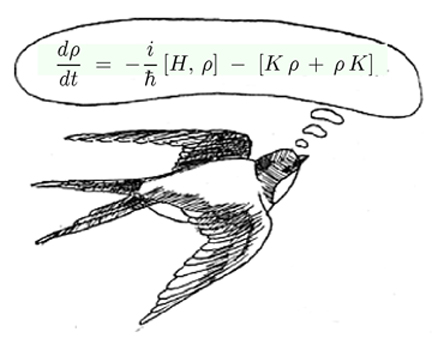
Around this same time, Schulten was invited back to Harvard and gave a lecture about magnetic field effects in chemistry. He covered such things as solving the Liouville equations for the chemical reaction of interest, and how the reaction in the laboratory was induced by a short laser flash. He ended the talk with a discussion of how this might play a role in a bird compass. His last slide was a cartoon of a swallow in flight, with the Liouville equation emanating from the thought cloud above the bird's head.
Sitting in the front row was Dudley Herschbach, who would later win a Nobel Prize in 1986 in Chemistry. He had been one of Schulten's professors, and had always been supportive. At the close of the talk, he raised his hand and asked Schulten, “But Klaus, where in the bird is the laser?” Schulten admitted that this was a problem, and that he thought that it could be done thermally.
However, Herschbach's humorous question prompted Schulten to convert a problem into an opportunity. Although he had long pondered the problem, Schulten recalls: “But if somebody asked you this question at such a pivotal moment, like giving a lecture at Harvard, you think about it more. And then I thought suddenly, ‘Oh, maybe it is actually light that is playing a role.’” This convinced Schulten that the magnetic sensor was in the eye, and that light was a key ingredient for the compass.
Around this time, something intrigued Wolfgang Wiltschko as he read Nature one day in 1977. A physicist at Oxford, Mike Leask, was proposing that in birds, rhodopsin (a light-capturing molecule, or photopigment) in the retina could function as a chemical detector for magnetic fields, sort of an application of light-dependent optical pumping. This coincided with Wolfgang Wiltschko's intuition at the time: “I had some hints that the visual system might be involved in magnetoreception in robins. That was not really having data, that was more a feeling out of observation.”
The Wiltschkos had already shown in 1978 that transporting homing pigeons in altered magnetic fields to a release site disrupted navigation on the journey back. Inspired by the idea of Leask, they now transported their pigeons on the roof of a Volkswagen bus in total darkness to the release site, and again saw the disruption in navigation. They conclude, in their 1981 Nature article, that this was not proof enough of Leask's mechanism, which in fact, turned out to be incorrect. Yet the Wiltschkos had their first confirmation that light was integral. As Wolfgang summarizes, “All the mechanisms we were thinking were wrong, but the outcome was right.”
When Klaus Schulten finally met the Wiltschkos, a more beautiful meeting spot than Les Houches in the French Alps could not have been planned. In late February, 1986, a workshop was held at the ski resort with the intent to bring together scientists across disciplines who had one thing in common: the biophysical effects of magnetic fields. Schulten had a great time walking around the area with the couple while they imitated bird calls. And of course they talked about the radical pair mechanism.
Wolfgang Wiltschko says that he was convinced Schulten's radical pair hypothesis was the correct mechanism after he and Roswitha conducted their 1992 experiments, using different wavelengths of light, with Australian collaborators Ursula Munro and Hugh Ford. The idea to subject the birds to either red, blue, or green light came from a very simple consideration. As Wolfgang states, “if a photopigment is responsible for magnetoreception, then not every wavelength of light can do that job.” The study showed that the silvereyes could not orient under red light, thus lending credence to the idea that light, probably blue or green, was integral for the radical pair mechanism to work.
Over a Decade of Waiting
At this time, the Wiltschkos were not the only ones wondering what molecule in the eye could be responsible for magnetoreception. Although in 1978 Schulten proposed that the radical pair mechanism acts as a magnetic compass, he did not postulate in that paper what molecule formed the radical pairs. But he was constantly thinking about it, and writing and re-writing a paper with hypothetical candidates. His intuition told him, however, that none of his candidates were the correct ones. He says he kept that paper in his drawer for about ten years, but it was probably there much longer.
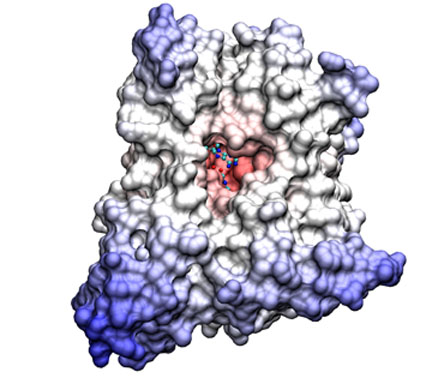
Cryptochrome, the candidate molecule for the avian magnetic compass, proposed in 2000. Image provided by Ilia Solov'yov.
The French scientist Louis Pasteur once said, “Chance favors the prepared mind.” On the day in 1998 when Schulten read that cryptochrome was found in the eye, he was already well prepared. While at conferences over the years Schulten had talked to his good friend Johann Deisenhofer about light sensor proteins called photolyases and their close relatives the cryptochromes. Schulten knew that cryptochromes were all over the brain, responsible for circadian rhythm regulation, and most likely descended from the photolyases. Deisenhofer, who won the 1988 Nobel Prize in Chemistry for his work on the structure of certain proteins in photosynthesis, had solved the crystal structure of photolyase in 1995. A critical fact Schulten had filed away was that cryptochrome likely formed radical pairs. “And there suddenly it was on a silver platter,” recounts Schulten. “So I realized there was a good chance that it was a good candidate.”
Thorsten Ritz was a graduate student working on photosynthesis with Schulten at the time, but he had always been fascinated by magnetoreception. Ritz heard Schulten talk about the radical pair mechanism when just an undergraduate student at the University of Frankfurt, and it left a lasting impression, he says, “because it's one of the projects where quantum mechanics can really play a role in biology.”
Schulten's group, now located at the University of Illinois at Urbana-Champaign, was a large one, and Schulten liked for people in the group to train each other. Ritz jumped at the chance to mentor undergraduate student Salih Adem and work on the cryptochrome project. They did some straightforward calculations, re-checked earlier calculations, improved the presentation, and then made their point about cryptochrome.
Publication of their article in 2000 was a germinal moment for the radical pair mechanism in magnetoreception. The paper systematically showed how one can turn a magnetic field-dependent process into a visual impression. Schulten believes the paper is highly cited for two reasons. First, they worked out in some detail the role the eye could play in the magnetic compass. And second, they had a strong candidate in cryptochrome.
Key Findings in the Recent Decade
Since that 2000 paper, the work related to magnetoreception involving the radical pair mechanism and cryptochrome has skyrocketed, compared to the 1980s and 1990s. A summary of that research is beyond the scope of this history, but there are many recent review articles that sketch out the developments in this decade, principally Solov'yov et al. (2011), Ritz et al. (2010), and Rodgers and Hore (2009).
Current researchers in the field, including Schulten, Ritz, and Ilia Solov'yov, point to a few key findings that are critical. The group of Henrik Mouritsen, in Oldenburg, Germany, has identified a brain center, dubbed “cluster N,” that is active during the night migration behavior of birds and that is part of the visual system. With bilateral lesioning of cluster N, effectively destroying this brain center, they found that the magnetic compass of these birds doesn't work anymore, but they can still orient to the star and sun compass. This provides strong evidence of a visual brain center linked to magnetoreception.
Cryptochrome is an evolving story, but according to Thorsten Ritz, there is no smoking gun just yet. However, Margaret Ahmad, working with Ritz, the Wiltschkos, and Paul Galland, found magnetic field effects on plants that are mediated by cryptochromes, providing evidence for magnetic effects on an in vivo system.
Another interesting piece of the cryptochrome story comes out of the neurobiology department at the University of Massachusetts Medical School. Steven Reppert's group trained flies to find food in a magnetic field under visible light. First, when the blue light part of the spectrum was blocked, the flies couldn't orient, suggesting that cryptochrome, which needs blue light, was involved. Also, mutant flies deficient in cryptochrome couldn't orient either.
Eye-Opening Revelations
While the first decade of the twenty-first century was erupting with such new results as the ones mentioned above, along with a host of others, and with new researchers entering the field, Schulten and the Wiltschkos have continued to attack the unresolved questions of magnetoreception. Although the projects the Wiltschkos completed in this decade are numerous, and are summarized in a review article by Wiltschko and Wiltschko (2006), they were involved in a particularly critical study, one with oscillating magnetic fields, that has helped advance the radical pair hypothesis. But the story behind that can be encapsulated best by Robert Schuller's quote, “Problems are not stop signs, they are guidelines.”
|
"THE LONGER YOU WORK ON A PROBLEM THE HARDER IT ACTUALLY GETS." Klaus Schulten |
After the landmark 2000 cryptochrome paper, Thorsten Ritz, with the help of Klaus Schulten, got a fellowship to pursue a post-doc with John Phillips to study the magnetic compass of fruit flies. A biologist at Virginia Tech, Phillips had published extensively on magnetoreception in amphibians, reptiles, and birds. Phillips and Ritz wanted to subject fruit flies to oscillating magnetic fields. If the radical pair mechanism is responsible for the magnetic sensor, then these radio frequency fields would affect the singlet-triplet interconversion and disrupt orientation. “The basic idea is simple,” Ritz says of oscillating magnetic fields, “and that's often the best. When you have a simple idea, that can be convincing.”
And in this study, cryptochrome wasn't far from their thoughts: “The benefit of working with fruitflies is, of course,” says Ritz, “that it's a genetic system. So you could have knocked out the cryptochrome to see what happens.”
The project required two main facets: an experimental set-up to generate the oscillating fields, and an animal to test. But Phillips and Ritz couldn't get the control group of fruit flies to orient. They had their experimental set up, and now no animal to test, but an opportunity soon presented itself.
When Ritz first met the Wiltschkos in April of 2001 at the Animal Navigation Group meeting, he really had to sell them on the idea of subjecting their birds to oscillating magnetic fields. They liked what Ritz had proposed in the 2000 paper with Schulten, but were skeptical about this new idea. Ritz recounts the hesitations they voiced: “You know that if we see a disruptive effect of the oscillating fields, that is a good indication for the radical pair mechanism. But what if we don't see an effect? What do we learn then?”
Ritz was trained as a theorist, and the Wiltschkos were trained as experimentalists, and these two sides had to learn how to talk to each other. Ritz conveys the epiphany he had that day: “So they didn't want something where you only learn something if there was one particular outcome. And that was something I never thought about. I had never done experiments before. I was a pure theorist. It was very important to them.”
When Ritz convinced the Wiltschkos that, either way, they would learn something about the radical pair mechanism, they were eager then to do the experiment during the next migratory season, which was seven or eight months away. Ritz admits that time scales are a different matter too, as over a half a year is a long time for a theorist to wait, but relatively immediate for behavioral biologists. Eventually the study was conducted, and when it was shown that the birds were disoriented in oscillating magnetic fields, more evidence had accumulated for the radical pair hypothesis.
Collaboration a Key to Success
Much as the Wiltschkos have chipped away at magnetoreception in this past decade, Klaus Schulten too continues to investigate this topic. He has an interesting viewpoint about what it means to study one topic for over thirty-five years: “If you want to solve a problem, it takes a lot. And the longer you work on a problem the harder it actually gets. And so you need then a series of very good collaborators, particularly towards the end.”
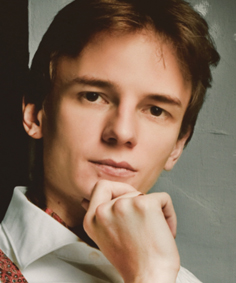
Ilia Solov'yov, now a post-doctoral researcher with Klaus Schulten in Urbana.
Schulten feels particularly grateful for his string of exceptional collaborators over the years, starting with Hans-Joachim Werner in 1975 at the Max Planck Institute, and at this late stage in the project believes he found the perfect collaborator in Ilia Solov'yov. In 2004 Solov'yov had just finished his diploma (more or less equivalent to a U.S. masters) in Physics at J. W. Goethe University in Frankfurt, and was starting on his Ph.D. work there. Although he had just completed theoretical studies on atomic clusters of small nanoparticles for his diploma, he wanted next to do something more closely related to experiment. One of his professors, Walter Greiner, said he would introduce Solov'yov to Klaus Schulten, who would be visiting Frankfurt often since Schulten had just won the Humboldt Research Award. The two met, talked awhile, and ironed out their first project. From then on, Solov'yov would visit Schulten in Urbana from time to time in the course of their collaborations. “So basically every time he came,” says Schulten, “we wrote a pretty weighty paper.” But that was not all, for Schulten continues, “and within days, always within days, we had the next project.”
For their first two projects, they described cryptochrome in extensive quantitative detail, and then showed how the compound superoxide may play a role in the radical pair mechanism. Their third project, with Henrik Mouritsen, explained how cryptochrome does not need to be held extremely rigid to get magnetic field compass action. Their next projects will involve collaborations with experimentalists.
This story, of magnetoreception via cryptochrome and the radical pair mechanism, likely will evolve even further over the next decade as more and more researchers join the hunt. The only thing that seems predictable is that it will involve surprises. But another motif rings true as well: multi-disciplinary collaboration. Behavioral biologists, molecular biologists, physical chemists, theoretical physicists, and perhaps other researchers will need to continue to form joint teams to tackle this enigma. They will need to craft fundable joint projects and then communicate patiently with each other. But the results will be well worth it, to explain a sense that has captivated and inspired human imagination for decades
Other Related Articles
If you enjoyed this article, you might be interested in these other histories:History of Polyenes
History of Membrane Proteins
History of Bionanotechnology
History of Photosynthesis
History of NAMD
History of VMD
History of MDFF (Molecular Dynamics Flexible Fitting)
Acknowledgements
Lisa Pollack would like to thank: Ilia Solov'yov, for basically teaching me radical pair theory, Sandra Haddad for her excellent biology lessons, and historian Sandra Henderson for sharing the tricks of her trade.Comments?
For comments or inquiries, Lisa Pollack can be reached at the following: lpollack AT ks.uiuc.eduCitation
To cite this article, please use the following:Pollack, Lisa. "That Nest of Wires We Call the Imagination: A History of some Key Scientists Behind the Bird Compass Sense." www.ks.uiuc.edu. 1 July 2012, from http://www.ks.uiuc.edu/History/magnetoreception
References
The phrase "that nest of wires we call the imagination" is from the poem "Acid" by Mary Oliver, in New and Selected Poems Volume One (Boston: Beacon Press, 1992), 130.
Klaus Schulten, Hubert Staerk, Albert Weller, Hans-Joachim Werner, and B. Nickel. Magnetic Field Dependence of the Geminate Recombination of Radical Ion Pairs in Polar Solvents. Zeitschrift für Physikalische Chemie, NF101:371-390, 1976.
M.E. Michel-Beyerle, R. Haberkorn, W. Bube, E. Steffens. H. Schröder, H.J. Neusser, E.W. Schlag, and H. Seidlitz. Magnetic Field Modulation of Geminate Recombination of Radical Ions in a Polar Solvent. Chemical Physics, 17:139-145, 1976.
Ulrich E. Steiner and Thomas Ulrich. Magnetic Field Effects in Chemical Kinetics and Related Phenomena. Chemical Reviews, 89:51-147, 1989.
A. L. Buchachenko, E. M. Galimov, V. V. Ershow, G. A. Nikiforov, and A. D. Pershin, Doklady Akademii Nauk SSSR, 228:379, 1976.
Y. Tanimoto, H. Hayashi, S. Nagakura, H. Sakuragi, and K. Tokumaru. The External Magnetic Field Effect on the Singlet Sensitized Photolysis of Dibenzoyl Peroxide. Chemical Physics Letters, 41:267-269, 1976.
R. Z. Sagdeev, Yu. N. Molin, K. M. Salikhov, T. V. Leshina, M. A. Kamha, and S. M. Shein. Effects of Magnetic Field on Chemical Reactions. Organic Magnetic Resonance, 5:603-605, 1973.
Klaus Schulten, Charles E. Swenberg, and Albert Weller. A Biomagnetic Sensory Mechanism Based on Magnetic Field Modulated Coherent Electron Spin Motion. Zeitschrift für Physikalische Chemie, NF111:1-5, 1978.
Wolfgang Wiltschko and Friedrich W. Merkel. Orientierung zugunruhiger Rotkehlchen im statische Magnetfeld. Verhandlungen der Deutschen Zoologischen Gesellschaft, 59:362-367, 1966.
Stephen T. Emlen, Wolfgang Wiltschko, Natalie J. Demong, Roswitha Wiltschko, and Simon Bergman. Magnetic Direction Finding: Evidence for Its Use in Migratory Indigo Bunting. Science, 193:505-508, 1976.
Thorsten Ritz, Salih Adem, and Klaus Schulten. A Model for Photoreceptor-Based Magnetoreception in Birds. Biophysical Journal, 78:707-718, 2000.
Ilia A. Solov'yov, P. J. Hore, Thorsten Ritz, and Klaus Schulten. A chemical compass for bird navigation. In Masoud Mohseni, Yasser Omar, Greg Engel, and Martin B. Plenio, editors, Quantum Effects in Biology, chapter 10. Cambridge University Press, 2012. To be published.
Thorsten Ritz, Margaret Ahmad, Henrik Mouritsen, Roswitha Wiltschko, and Wolfgang Wiltschko. Photoreceptor-Based Magnetoreception: Optimal Design of Receptor Molecules, Cells, and Neuronal Processing. Journal of the Royal Society Interface, 7:S135-S146, 2010.
Christopher T. Rodgers and Peter J. Hore. Chemical Magnetoreception in Birds: The Radical Pair Mechanism. Proceedings of the National Academy of Sciences, 106:353-360, 2009.
Roswitha Wiltschko and Wolfgang Wiltschko. Magnetoreception. BioEssays, 28:157-168, 2006.
Ilia A. Solov'yov, Danielle E. Chandler, and Klaus Schulten. Magnetic field effects in Arabidopsis thaliana cryptochrome-1. Biophysical Journal, 92:2711-2726, 2007.
Ilia A. Solov'yov and Klaus Schulten. Magnetoreception through cryptochrome may involve superoxide. Biophysical Journal, 96:4804-4813, 2009.

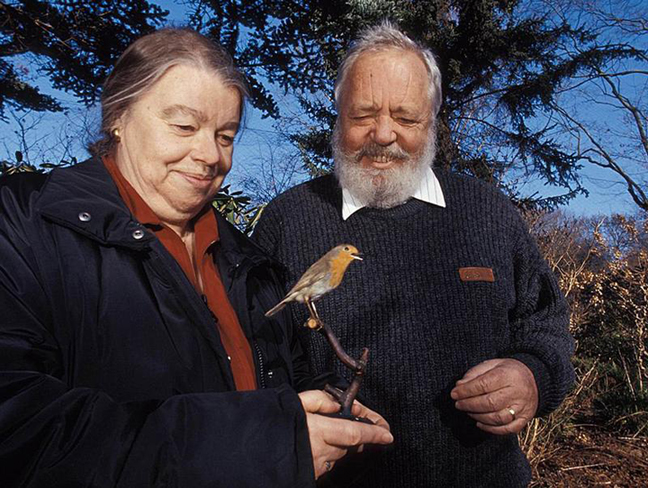 Roswitha and Wolfgang Wiltschko and a European Robin.
Photo taken from
Roswitha and Wolfgang Wiltschko and a European Robin.
Photo taken from


